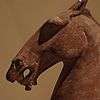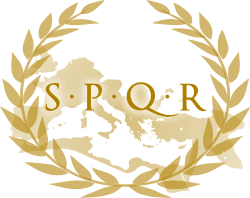Sino-Roman relations
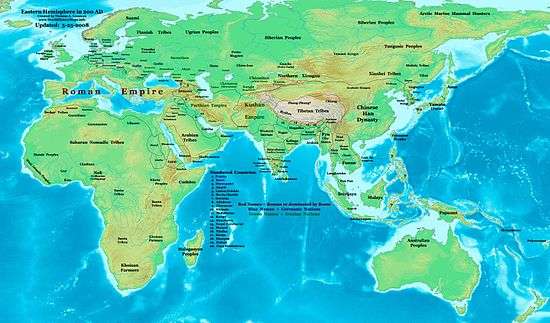
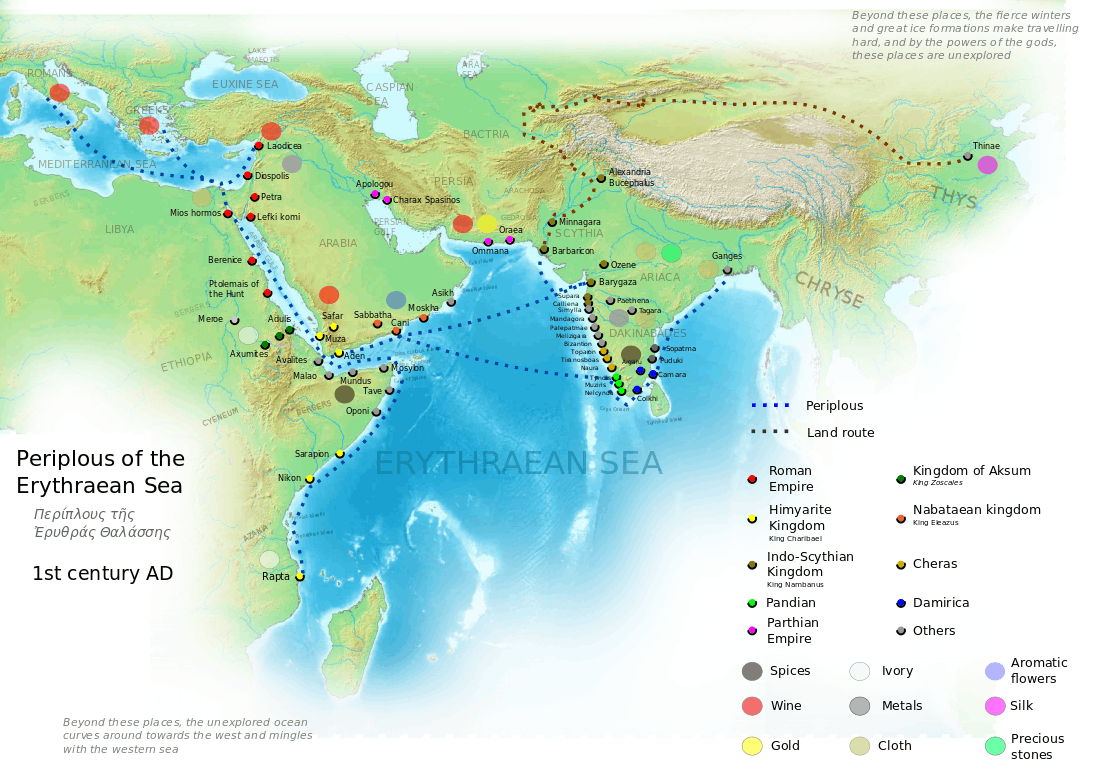
Sino-Roman relations were essentially indirect throughout the existence of both empires. The Roman Empire and the ancient Han dynasty progressively inched closer in the course of the Roman expansion into the Ancient Near East and simultaneous Chinese military incursions into Central Asia. However, powerful intermediate empires such as the Parthians and Kushans kept the two Eurasian flanking powers permanently apart and mutual awareness remained low and knowledge limited. Only a few attempts at direct contact are known from records. In 97 AD, the Chinese general Ban Chao tried to send his envoy Gan Ying to Rome, but Gan was dissuaded by Parthian authorities from venturing beyond the Persian Gulf.[1][2] Several alleged Roman emissaries to China were recorded by ancient Chinese historians. The first one on record, supposedly from either the Roman emperor Antoninus Pius or his adopted son Marcus Aurelius, arrived in 166 AD.[3][4] Others are recorded as arriving in 226 and 284 AD, with a long absence until the first recorded Byzantine embassy in 643 AD.[5]
The indirect exchange of goods on the land along the Silk Road and sea routes included Chinese silk, Roman glassware and high-quality cloth.[6] Roman coins minted from the 1st century AD onwards have been found in China, as well as a coin of Maximian and medallions from the reigns of Antoninus Pius and Marcus Aurelius in Vietnam, the same region Chinese sources claim the Romans first landed. Roman glasswares and silverwares have been discovered at Chinese archaeological sites dated to the Han period. Roman coins and glass beads have also been found in Japan.
In classical sources, the problem of identifying references to ancient China is exacerbated by the interpretation of the Latin term "Seres", whose meaning fluctuated and could refer to a number of Asian people in a wide arc from India over Central Asia to China.[7] In Chinese records, the Roman Empire came to be known as "Daqin" or Great Qin.[8] Daqin was directly associated with the later "Fu lin" (拂菻) in Chinese sources, which has been identified by scholars such as Friedrich Hirth as the Byzantine Empire.[9][10] Chinese sources describe several embassies of Fu lin arriving in China during the Tang dynasty and also mention the siege of Constantinople by the forces of Muawiyah I in 674–678 AD.
In terms of geography, Roman geographers such as Ptolemy provided a rough sketch of the eastern Indian Ocean, including the Malay Peninsula and beyond this the Gulf of Thailand and South China Sea. Ptolemy's Cattigara was most likely Óc Eo, Vietnam, where Antonine-era Roman items have been found. Ancient Chinese geographers demonstrated a general knowledge of West Asia and Rome's eastern provinces. The 7th-century AD Byzantine historian Theophylact Simocatta wrote of the contemporary reunification of northern and southern China, which he treated as separate nations recently at war. This mirrors both the conquest of Chen by Emperor Wen of Sui (r. 581–604 AD) as well as the names Cathay and Mangi used by later medieval Europeans in China during the Mongol-led Yuan dynasty and Han-Chinese Southern Song dynasty.
Geographical accounts and cartography
Roman geography
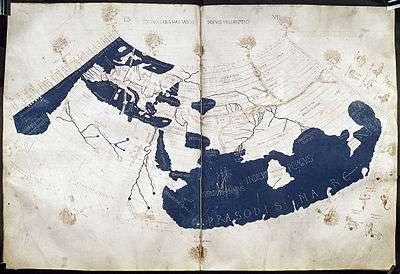
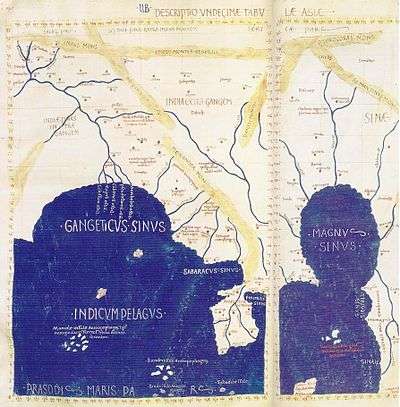
Beginning in the 1st century BC with Virgil, Horace, and Strabo, Roman histories offer only vague accounts of China and the silk-producing Seres of the Far East.[11] Florus seems to have confused the Seres with peoples of India, or at least noted that their skin complexions proved that they both lived "beneath another sky" than the Romans.[11] The 1st-century AD geographer Pomponius Mela asserted that the lands of the Seres formed the center of the coast of an eastern ocean, flanked to the south by India and to the north by the Scythians of the Eurasian Steppe.[11] The historian Ammianus Marcellinus (c. 330 – c. 400 AD) wrote that the land of the Seres was enclosed by great natural walls around a river called Bautis, possibly a description of the Yellow River.[11] While the existence of China was clearly known to Roman cartographers, their understanding of it was rather murkier. Ptolemy's 2nd-century AD Geography separates the Land of Silk (Serica) at the end of the overland Silk Road from the land of the Qin (Sinae) reached by sea.[12] The Sinae are placed on the northern shore of the Great Gulf (Magnus Sinus) east of the Golden Peninsula (Aurea Chersonesus, Malay Peninsula). Their chief port, Cattigara, seems to have been in the lower Mekong Delta.[13] The Great Gulf served as a combined Gulf of Thailand and South China Sea, as Marinus of Tyre and Ptolemy's belief that the Indian Ocean was an inland sea caused them to bend the Cambodian coast south beyond the equator before turning west to join southern Libya (Africa).[14][15] Much of this is simply given as unknown lands, but the northeastern area is placed under the Sinae.
Classical geographers such as Strabo and Pliny the Elder were generally slow to incorporate new information into their works and, from their positions as esteemed scholars, were seemingly prejudiced against lowly merchants and their topographical accounts.[16] Ptolemy's work represents somewhat of a break from this since he demonstrated an openness to their accounts and would not have been able to chart the Bay of Bengal so accurately had it not been for the input of traders.[16] In the 1st-century AD Periplus of the Erythraean Sea, its anonymous Greek-speaking author, a merchant of Roman Egypt, provides such vivid accounts of trade cities in Arabia, Pakistan, and India, including travel times from rivers and towns, where to drop anchor, the locations of royal courts, lifestyles of the locals and goods found in their markets, and favorable times of year to sail from Egypt to these places in order to catch the monsoon winds, that it is clear he visited many of these locations.[17] The Periplus also mentions a great inland city, Thinae (i.e. Sinae) in a country called This that perhaps stretched as far as the Caspian.[18][19] The text notes that silk produced there traveled to neighboring India via the Ganges River and to Bactria by a land route.[18] It is perhaps no surprise then that Marinus and Ptolemy had relied on the testimony of a Greek sailor named Alexander, most likely a merchant, for how to reach Cattigara (most likely Oc Eo, Vietnam).[13][20] Alexander (Greek: Alexandros) mentions how the main terminus for Roman traders was a Burmese city called Tamala on the northwest Malay Peninsula, where Indian merchants travelled overland across the Kra Isthmus to reach the Perimulic Gulf (i.e. Gulf of Thailand).[21] Alexandros claimed that it took twenty days to sail from Thailand to a port called "Zabia" (or Zaba) in southern Vietnam.[21][22] According to him, one could continue along the coast (of southern Vietnam) from Zabia until reaching the trade port of Cattigara after an unspecified amount of days (with "some" being interpreted as "many" by Marinus).[21][22]
Cosmas Indicopleustes, a 6th-century AD Eastern Roman (i.e. Byzantine) Greek monk from Alexandria and former merchant with experience in the Indian Ocean trade, was the first Roman to speak clearly about China in his Christian Topography (c. 550 AD).[23] He called it the country of Tzinista (comparable to Sanskrit Chinasthana and Syriac Sinistan from the 781 AD Nestorian Stele of Xi'an, China), located in easternmost Asia.[24][25] He explained the maritime route towards it (first sailing east and then north up the southern coast of the Asian continent) and the fact that cloves came that way to Sri Lanka for sale.[24] By the time of the Eastern Roman ruler Justinian I (r. 527–565 AD), the Byzantines purchased Chinese silk from Sogdian intermediaries.[26] However, they also smuggled silkworms out of China with the help of Nestorian monks, who claimed that the land of Serindia was located north of India and produced the finest silk.[26] By smuggling silkworms and producing silk of their own, the Byzantines could bypass the Chinese silk trade dominated by their chief rivals, the Sasanian Empire.[27]
From Turkic peoples of Central Asia the Eastern Romans derived another name for China, Taugast (Old Turkic: Tabghach), during its Northern Wei (386–535 AD) period.[26] Theophylact Simocatta, a historian during the reign of Heraclius (r. 610–641 AD), wrote that Taugast (or Taugas) was a great eastern empire colonized by Turkic people, with a capital city 1,500 miles (2,400 km) northeast from India that he called Khubdan (from the Turkic word Khumdan used for the Sui and Tang capital Chang'an), where idolatry was practiced but the people were wise and lived by just laws.[28] He depicted the Chinese empire as being divided by a great river (i.e. the Yangzi) that served as the boundary between two rival nations at war, yet during the reign of Byzantine Emperor Maurice (582–602 AD) the northerners wearing "black coats" conquered the "red coats" of the south (black being a distinctive color worn by the people of Shaanxi, location of the Sui capital Sui Chang'an, according to the 16h-century Persian traveler Hajji Mahomed, or Chaggi Memet).[29] This account may correspond to the conquest of the Chen dynasty and reunification of China by Emperor Wen of Sui (r. 581–604 AD).[29] Simocatta names their ruler as Taisson, which he claimed meant Son of God, either correlating to the Chinese Tianzi (i.e. Son of Heaven) or even the name of the contemporary ruler Emperor Taizong of Tang (r. 626 – 649 AD).[30] Later medieval Europeans in China would write of it as two separate countries, with Cathay in the north and Mangi in the south, during the period in which the Yuan dynasty led by Mongol ruler Kublai Khan (r. 1260–1294 AD) conquered the Southern Song Dynasty.[31][32][33]
Chinese geography

Detailed geographical information about the Roman Empire, at least its easternmost territories, are provided in traditional Chinese historiography. The Shiji by Sima Qian (c. 145–86 BC) provided descriptions of countries in Central Asia and West Asia. These accounts became significantly more nuanced in the Book of Han, co-authored by Ban Gu and his sister Ban Zhao, younger siblings of the general Ban Chao, who led military exploits into Central Asia before returning to China in 102 AD.[9] However, the westernmost territories of Asia as described in the Book of Later Han compiled by Fan Ye (398–445 AD) formed the basis for virtually all later accounts of Daqin.[9][34] These accounts seem to be restricted to descriptions of the Levant, particularly Syria.[9] Historian Edwin G. Pulleyblank explains how Chinese historians considered Daqin to be a kind of "counter-China" located at the opposite end of their known world.[8] According to Pulleyblank, the "point that needs to be stressed is that the Chinese conception of Da Qin was confused from the outset with ancient mythological notions about the far west".[4] The Chinese histories explicitly related Daqin and "Li-kan" (i.e. Syria) as belonging to the same country, with the earliest descriptions of Li-kan in the Shiji distinguishing it as the Hellenistic-era Seleucid Empire.[35][36]
The Weilüe by Yu Huan (c. 239–265 AD), preserved in the Records of the Three Kingdoms published in 429 AD by Pei Songzhi, also provides details about the easternmost portion of the Roman world, including mention of the Mediterranean Sea.[9] For Roman Egypt, the book explains its tripartite division of the Nile Delta, Heptanomis, and Thebaid, the location of Alexandria and traveling distances along the Nile River, among other details.[9][37] In his Zhu fan zhi, the Song-era Quanzhou customs inspector Zhao Rugua (1170–1228 AD) described the ancient Lighthouse of Alexandria.[38] Both the Book of Later Han and the Weilüe mention the "flying" (飛橋) pontoon bridge over the Euphrates at Zeugma, Commagene in Roman Anatolia.[9][39] The Weilüe also listed what it considered the most important dependent vassal states of the Roman Empire, providing travel directions and estimates for the distances between them (in Chinese miles, li).[9][37] Some of the locations and dependent states of Rome in the Weilüe that were identified by Friedrich Hirth (1885) have been contradicted by John E. Hill (2004).[40] For instance Hirth identified Si-fu (Chinese: 汜復) as Emesa,[9] yet Hill provides extensive linguistic and situational evidence to argue it was Petra in the Nabataean Kingdom, which was annexed by Rome in 106 AD during the reign of Trajan.[39]
Both the Old Book of Tang and New Book of Tang record that the Arabs (Da shi 大食) sent their commander "Mo-yi" (摩拽伐之, Pinyin: Mó zhuāi fá zhī, i.e. Muawiyah I, the governor of Syria before becoming the Umayyad caliph, r. 661–680 AD) to besiege the Byzantine capital, Constantinople, and forced the Byzantines to pay them tribute.[9] The same books also described Constantinople in some detail as having massive granite walls and a water clock mounted with a golden statue of man.[9][41][42] Henry Yule expressed some amazement that even the name of the Byzantine negotiator "Yenyo" (i.e. the patrician John Pitzigaudes) was mentioned in Chinese sources, an envoy who was unnamed in Edward Gibbon's account of the man sent to Damascus to hold a parley with the Umayyads, followed a few years later by the increase of tributary demands on the Byzantines.[43] The New Book of Tang and Wenxian Tongkao described the land of Nubia (either the Kingdom of Kush or Aksum) as a desert southwest of the Byzantine Empire that was infested with malaria, where the natives had black skin and primarily consumed Persian dates.[9] In discussing the three main religions of Nubia (i.e. the Sudan), the Wenxian Tongkao mentions the "Daqin" religion there and the day of rest occurring every seven days (i.e. Sabbath) for those following the faith of the Da shi (i.e. the Muslim Arabs).[9] It also repeats the claim in the New Book of Tang about the Eastern Roman surgical practice of trepanning to remove parasites from the brain.[9]
Embassies and travels

Some early contacts may have occurred between Hellenistic Greeks and the Qin dynasty in the late 3rd century BC, following the campaigns of Alexander the Great in Central Asia and the establishment of Hellenistic kingdoms relatively close to China, such as the Greco-Bactrian Kingdom. Recent excavations at the burial site of China's first Emperor Qin Shi Huang (r. 221-210 BC), suggest Greek stylistic and technological influences in the artworks found there, including in the manufacture of the famous Terracotta army.[45][46] Although cultural exchanges at such an early date are still widely considered as conjecture in academia, excavations of a 4th-century BC tomb in Gansu province belonging to the State of Qin have yielded Western items such as glass beads and a blue-glazed (possibly faience) beaker of Mediterranean origin.[47]
Embassy to Augustus
The 2nd-century AD Roman historian Florus describes the visit of numerous envoys, including the "Seres" (possibly the Chinese) to the first Roman Emperor Augustus (r. 27 BC – 14 AD):
Even the rest of the nations of the world which were not subject to the imperial sway were sensible of its grandeur, and looked with reverence to the Roman people, the great conqueror of nations. Thus even Scythians and Sarmatians sent envoys to seek the friendship of Rome. Nay, the Seres came likewise, and the Indians who dwelt beneath the vertical sun, bringing presents of precious stones and pearls and elephants, but thinking all of less moment than the vastness of the journey which they had undertaken, and which they said had occupied four years. In truth it needed but to look at their complexion to see that they were people of another world than ours.[48]
In the vast corpus of Roman literature and historiography, Henry Yule was unable to uncover any other mention of such a direct diplomatic encounter between the Romans and the Seres.[49] He speculated that these individuals were most likely private merchants instead of diplomats, since Chinese records insist that Gan Ying was the first Chinese to reach as far west as Tiaozhi (条支; Mesopotamia).[49] However, Yule notes that the 1st-century Periplus did mention that people of Thinae (Sinae) were to be seen on rare occasion, on account of the difficulties of reaching that country.[18][19] It states that their country, located under the Ursa Minor and on the farthest unknown reaches of the Caspian Sea, was the origin of raw silk and fine silk cloth that was traded overland from Bactria to Barygaza, as well as down the Ganges river.[18]
Envoy Gan Ying

The Eastern Han general Ban Chao (32–102 AD), in a string of military successes that brought the Western Regions (i.e. Tarim Basin of Xinjiang) back under Chinese control and suzerainty, defeated the Da Yuezhi in 90 AD and the Northern Xiongnu in 91 AD, gaining the submission of city-states such as Kucha and Turfan, Khotan and Kashgar (Indo-European Tocharian and Saka settlements, respectively),[50] and finally Karasahr in 94 AD.[51][52] An embassy from the Parthian Empire of Persia and Mesopotamia had earlier arrived at the Han court in 89 AD and, while Ban was stationed with his army in Khotan, another Parthian embassy came in 101 AD, this time bringing exotic gifts such as ostriches.[53]
In 97 AD, Ban Chao sent an envoy named Gan Ying to explore the far west. Gan made his way from the Tarim Basin to Parthia and reached the Persian Gulf.[54] Gan left a detailed account of western countries, although he apparently only reached as far as Mesopotamia, then under the control of the Parthian Empire. While he intended to sail to the Roman Empire, he was discouraged when told that the dangerous trip could take up to two years. Deterred, he returned home to China bringing much new information on the countries to the west of Chinese-controlled territories,[55] as far as the Mediterranean.[54]
Gan Ying is thought to have left an account of the Roman Empire (Daqin in Chinese) which relied on secondary sources—likely sailors in the ports which he visited. The Book of Later Han locates it in Haixi (lit. "west of the sea" = Roman Egypt,[9][56] which was then under Roman control; the sea is the one known to the Greeks and Romans as the Erythraean Sea, which included the Persian Gulf, the Arabian Sea, and Red Sea):[57]
Its territory extends for several thousands of li [a li during the Han dynasty equaled 415.8 metres].[58] They have established postal relays at intervals, which are all plastered and whitewashed. There are pines and cypresses, as well as trees and plants of all kinds. It has more than four hundred walled towns. There are several tens of smaller dependent kingdoms. The walls of the towns are made of stone.[57]
The Book of Later Han gives a positive, if somewhat fanciful, view of Roman governance:
Their kings are not permanent rulers, but they appoint men of merit. When a severe calamity visits the country, or untimely rain-storms, the king is deposed and replaced by another. The one relieved from his duties submits to his degradation without a murmur. The inhabitants of that country are tall and well-proportioned, somewhat like the Han [Chinese], whence they are called [Daqin].[9]
Yule described this interpretation of the Roman Constitution as rather vague and garbled, as well as the list of products given for the Roman Empire, yet pointed out that the Book of Later Han did offer an accurate depiction of the coral fisheries in the Mediterranean.[59] Coral was a highly valued luxury item in Han China, imported among other items from India (mostly overland and perhaps by sea), the latter region being where the Romans sold coral and obtained pearls.[60] The original list of Roman products given in the Book of Later Han, such as sea silk, glass, amber, cinnabar, and asbestos cloth, is expanded in the Weilüe.[37][61] The Weilüe also claimed that in 134 AD the ruler of the Shule Kingdom (i.e. Kashgar), who had been a hostage at the court of the Kushan Empire, offered blue (or green) gems originating from Haixi as gifts to the Eastern Han court.[37] Fan Ye, the author of the Book of Later Han, claimed that former generations of Chinese had never reached these regions so far west, yet the report of Gan Ying revealed to the Chinese their lands, customs and products.[62] The Book of Later Han also explicitly asserts that the Parthians (Chinese: 安息; Anxi) wished "to control the trade in multi-coloured Chinese silks" and therefore intentionally blocked the Romans from reaching China.[56]
Eastern travels of Maes Titianus
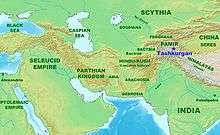
Maës Titianus, an ancient Roman traveller,[63] penetrated farthest east along the Silk Road from the Mediterranean world. In the early 2nd century AD[64] or at the end of the 1st century AD,[65] during a lull in the intermittent Roman struggles with Parthia, his party reached the famous Stone Tower, which, according to one theory, was Tashkurgan,[66] in the Pamirs. According to other writers, the "Stone Tower" must have been located in the Alai Valley, west of Kashgar.[67][68][69]
Possible Roman Greeks in Burma and China
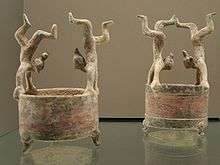
It is possible that a group of Greek acrobatic performers, who claimed to be from a place "west of the seas" (i.e. Roman Egypt, which the Book of Later Han related to the "Daqin" empire), were presented by a king of Burma to Emperor An of Han in 120 AD.[70][71][72] It is known that in both the Parthian Empire and Kushan Empire of Asia, ethnic Greeks continued to be employed as entertainers such as musicians and athletes who engaged in athletic competitions.[73][74] The Book of Later Han states that Emperor An transferred these entertainers from his countryside residence to the capital Luoyang, where they provided a performance at his court and were rewarded with gold, silver, and various gifts.[75] Raoul McLaughlin notes that the Romans knew Burma as India Trans Gangem (India Beyond the Ganges) and that Ptolemy even listed cities of Burma.[76] Mclaughlin also speculates that the Romans were selling slaves to the Burmese and that this is how the entertainers originally wound up in Burma before they were sent by the Burmese ruler to Emperor An in China.[76] While Syrian jugglers were renowned in Western Classical literature, Chinese sources from the 2nd century BC to 2nd century AD mention them as well.[77]
First Roman embassy

The first group of people claiming to be an ambassadorial mission of Romans to China was recorded as having arrived in 166 AD by the Book of Later Han. The embassy came to Emperor Huan of Han China from "Andun" (Chinese: 安敦; Emperor Antoninus Pius or Marcus Aurelius Antoninus), "king of Daqin" (Rome).[78][79] As Antoninus Pius died in 161 AD, leaving the empire to his adoptive son Marcus Aurelius Antoninus, and the envoy arrived in 166 AD, confusion remains about who sent the mission given that both Emperors were named "Antoninus".[3][4] The Roman mission came from the south (therefore probably by sea), entering China by the frontier of Rinan or Tonkin (present-day Vietnam). It brought presents of rhinoceros horns, ivory, and tortoise shell, probably acquired in Southern Asia.[3][80] The text specifically states that it was the first time there had been direct contact between the two countries.[3] Historians Rafe de Crespigny, Peter Fibiger Bang, and Warwick Ball believe that this was most likely a group of Roman merchants rather than official diplomats sent by Marcus Aurelius.[77][78][81] Crespigny stresses that the presence of this Roman embassy as well as others from Tianzhu (in northern India) and Buyeo (in Manchuria) provided much-needed "prestige" for Emperor Huan, as he was facing serious political troubles and fallout for the forced suicide of Liang Ji, who had dominated the Han government well after the death of his sister Empress Liang Na.[82] Henry Yule speculated that the Roman visitors must have lost their original wares due to robbery or shipwreck and used the aforementioned items as gifts instead, prompting the Chinese sources to accuse them of withholding their more precious valuables, which Yule deftly notes was the same criticism directed at papal missionary John of Montecorvino when he arrived in China in the late 13th century.[83] Yule also emphasized that the Roman embassy was said to come by way of Jiaozhi in northern Vietnam, the same route that Chinese sources claimed the embassies from Tianzhu (northern India) had arrived in 159 and 161 AD.[84]
Other Roman embassies


The Weilüe and Book of Liang record the arrival in 226 AD of a merchant named Qin Lun (秦論) from the Roman Empire (Da Qin) at Jiaozhi (Chinese-controlled northern Vietnam).[13][37][77] Wu Miao, the Prefect of Jiaozhi sent him to the court of Sun Quan (the ruler of Eastern Wu during the Three Kingdoms) in Nanjing,[13][77] where Sun requested that he provide him with a report on his native country and its people.[9][37] An expedition was mounted to return the merchant along with ten female and ten male "blackish coloured dwarfs" he had requested as a curiosity, as well as a Chinese officer, Liu Xian of Huiji (in Zhejiang), who unfortunately died en route.[9][37][85] The Weilüe and Book of Liang assert that Roman merchants were active in Cambodia and Vietnam, a claim supported by modern archaeologial finds of ancient Mediterranean goods in the Southeast Asian countries of Vietnam, Thailand, Malaysia, and Indonesia.[9][13][37]
Yule mentions how in the early 3rd century AD a ruler of Daqin sent an envoy with gifts to the northern Chinese court of Cao Wei (220–265 AD) that included glasswares of various colors.[86] Several years later a Daqin craftsman is mentioned as showing the Chinese how to make "flints into crystal by means of fire," which the Chinese noted with positive feedback.[86]
Another embassy from Daqin is recorded in the year 284 AD, as bringing tributary gifts to the Chinese Jin Empire (265–420 AD).[77] This occurred during the reign of Emperor Wu of Jin (r. 266–290 AD), and was recorded in the Book of Jin, as well as the later Wenxian Tongkao.[9][77] This embassy was presumably sent by the Emperor Carus (r. 282–283 AD), whose brief reign was preoccupied by war with Sasanian Persia.[5]
Fu-lin: Eastern Roman embassies
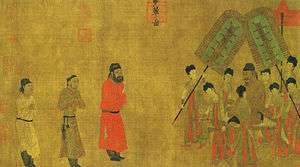
Chinese histories for the Tang dynasty (618–907 AD) record contacts with merchants from "Fu-lin" (拂菻), the new name used to designate the Byzantine Empire, the continuation of the Roman Empire in the east.[9][10] The first took place in 643 AD during the reigns of Constans II (641–668 AD) and Emperor Taizong of Tang (r. 626–649 AD).[9] Both the Old Book of Tang and New Book of Tang provide the name "Po-to-li" (Chinese: 波多力; Pinyin: Bō duō lì; after his name Kōnstantinos Pogonatos, or "Constantine the Bearded") for Constans II, giving him the title of a king (王 wáng).[9] They record that he sent an embassy in the 17th year (i.e. 643 AD) of the Zhenguan era (貞觀之治) bearing gifts of red glass and green gemstones.[9] Yule highlights the fact that Yazdegerd III (r. 632–651 AD), last ruler of the Sasanian Empire, sent diplomats to China for securing aid from Emperor Taizong (considered the suzerain over Ferghana in Central Asia) during the loss of the Persian heartland to the Islamic Rashidun Caliphate, which may have also prompted the Byzantines to send envoys to China amid their recent loss of Syria to the Muslims.[87] Tang Chinese sources also recorded how Sasanian prince Peroz III (636–679 AD) fled to Tang China following the conquest of Persia by the growing Islamic caliphate.[88]
Other Fu lin embassies during the Tang occurred in 711 and 719 AD, with another in 742 AD that may have simply been Nestorian monks instead of Byzantines.[89] The last contacts are recorded as having taken place in the 11th century AD. From the Wenxian Tongkao, written by historian Ma Duanlin (1245–1322 AD), and the History of Song it is known that the Byzantine emperor Michael VII Parapinakēs Caesar (Mie li sha ling kai sa 滅力沙靈改撒) of Fu lin sent an embassy to China's Song dynasty that arrived in 1081 AD, during the reign of Emperor Shenzong of Song (r. 1067–1085 AD).[9][90] The History of Song described the tributary gifts given by the Byzantine embassy as well as the products made in Byzantium. It also described forms of punishment in Byzantine law, such as the capital punishment of being stuffed into a "feather bag" and thrown into the sea.[9] This sort of punishment seems to correspond with the Romano-Byzantine practice of poena cullei (from Latin 'penalty of the sack').[91] The final recorded embassy arrived in 1091, during the reign of Alexios I Komnenos (r. 1081–1118), although this event is only mentioned in passing.[92]
The History of Yuan offers a biography of a Byzantine man named Ai-sie (transliteration of either Joshua or Joseph), who originally served the court of Güyük Khan but later became a head astronomer and physician for the court of Kublai Khan, the Mongol founder of the Yuan dynasty (1271–1368 AD), at Khanbaliq (modern Beijing).[93] He was eventually granted the noble title Prince of Fu lin (Chinese: 拂菻王; Fú lǐn wáng) and his children were listed with their Chinese names, which seem to match with transliterations of the Christian names Elias, Luke, and Antony.[93] Kublai Khan is also known to have sent Nestorian monks to the court of Byzantine ruler Andronikos II Palaiologos (r. 1282–1328), whose half-sisters were married to the great-grandsons of Genghis Khan, making this Byzantine ruler an in-law with the Mongol ruler in Beijing, China.[94]

Right image: A Western Han (202 BC – 9 AD) blue-glass bowl; although the Chinese had been making glass beads based on imports from West Asia since the Spring and Autumn period (722–481 BC), the first Chinese glasswares appeared during the Western Han era.[95]
Within the Mongol Empire, which eventually included all of China, there were enough Westerners travelling there that in 1340 AD Francesco Balducci Pegolotti compiled a guide book for fellow merchants on how to exchange silver for paper money to purchase silk in Khanbaliq (i.e. Beijing).[96] However, by this stage the Eastern Roman Empire, temporarily dismantled by the Latin Empire, had shrunk to the size of a rump state in parts of Greece and Anatolia.[97][98] Ma Duanlin, author of the Wenxian Tongkao, was perceptive enough to note the shifting political boundaries, albeit based on generally inaccurate and distorted political geography.[9] He wrote that historians of the Tang Dynasty considered "Da Qin" and "Fu lin" to be the same countries, yet he had his reservations about this due to discrepancies in geographical accounts and other concerns (Wade-Giles spelling):
During the sixth year of Yuan-yu [1091 C.E.] they sent two embassies, and their king was presented, by Imperial order, with 200 pieces of cloth, pairs of silver vases, and clothing with gold bound in a girdle. According to the historians of the T'ang dynasty, the country of Fu-lin was held to be identical with the ancient Ta-ts'in. It should be remarked, however, that, although Ta-ts'in has from the Later Han dynasty when Zhongguo was first communicated with, till down to the Chin and T'ang dynasties has offered tribute without interruption, yet the historians of the "four reigns" of the Sung dynasty, in their notices of Fu-lin, hold that this country has not sent tribute to court up to the time of Yuan-feng [1078–1086 C.E.] when they sent their first embassy offering local produce. If we, now, hold together the two accounts of Fu-lin as transmitted by the two different historians, we find that, in the account of the T'ang dynasty, this country is said "to border on the great sea in the west"; whereas the Sung account says that "in the west you have still thirty days' journey to the sea;" and the remaining boundaries do also not tally in the two accounts; nor do the products and the customs of the people. I suspect that we have before us merely an accidental similarity of the name, and that the country is indeed not identical with Ta-ts'in. I have, for this reason, appended the Fu-lin account of the T'ang dynasty to my chapter on Ta-ts'in, and represented this Fu-lin of the Sung dynasty as a separate country altogether.[9]
The History of Ming expounds how the Hongwu Emperor, founder of the Ming dynasty (1368–1644 AD), sent a merchant of Fu lin named "Nieh-ku-lun" (捏古倫) back to his native country with a letter announcing the founding of the Ming dynasty.[9][99][100] It is speculated that the merchant was actually a former archbishop of Khanbaliq called Nicolaus de Bentra (who succeeded John of Montecorvino for that position).[9][101] The History of Ming goes on to explain that contacts between China and Fu lin ceased after this point and an envoy of the great western sea (i.e. the Mediterranean Sea) did not appear in China again until the 16th century AD, with the 1582 AD arrival of the Italian Jesuit missionary Matteo Ricci in Portuguese Macau.[9][102]
Trade relations
Roman exports to China


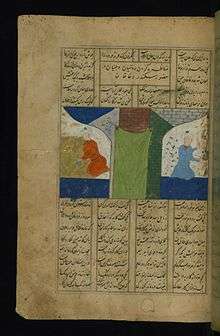
Direct trade links between the Mediterranean lands and India had been established in the late 2nd century BC by the Hellenistic Ptolemaic Kingdom of Egypt.[103] Greek navigators learned to use the regular pattern of the monsoon winds for their trade voyages in the Indian Ocean. The lively sea trade in Roman times is confirmed by the excavation of large deposits of Roman coins along much of the coast of India. Many trading ports with links to Roman communities have been identified in India and Sri Lanka along the route used by the Roman mission.[104] However, archaeological evidence stretching from the Red Sea ports of Roman Egypt to India suggests that Roman commercial activity in the Indian Ocean and Southeast Asia heavily declined with the Antonine Plague of 166 AD, coincidentally in the same year as the first Roman embassy to Han China, where similar plague outbreaks occurred (beginning years earlier in 151 AD).[105][106]
High-quality glass from Roman manufactures in Alexandria and Syria was exported to many parts of Asia, including Han China.[107] The first Roman glassware discovered in China is a blue soda-lime glass bowl dating to the early 1st century BC and excavated from a Western Han tomb in the southern port city of Guangzhou, which perhaps came there via the Indian Ocean and South China Sea.[108] Other Roman glass items include a mosaic-glass bowl found in a prince's tomb near Nanjing dated to 67 AD and a glass bottle with opaque white streaks found in an Eastern Han tomb of Luoyang.[109] Roman and Persian glasswares have been found in a 5th-century AD tomb of Gyeongju, Korea, capital of ancient Silla.[110] Roman glass beads have also been discovered as far as Japan, within the 5th-century AD Kofun-era Utsukushi burial mound near Kyoto.[111]
From Chinese sources it is known that other Roman luxury items were greatly esteemed by the Chinese. These include gold-embroidered rugs and gold-coloured cloth, asbestos cloth and sea silk, a cloth made from the silk-like hairs of certain Mediterranean shell-fish, the Pinna nobilis.[6][9][112] In addition to silver and bronze items found throughout China dated to the 3rd–2nd centuries BC and perhaps originating from the Seleucid Empire, there is also a Roman gilded silver plate dated to the 2nd–3rd centuries AD and found in Jingyuan County, Gansu, with a raised relief image in the center depicting the Greco-Roman god Dionysus resting on a feline creature.[113]
A maritime route opened up with the Chinese-controlled port of Rinan in Jiaozhi (centred in modern Vietnam) and the Khmer kingdom of Funan by the 2nd century, if not earlier.[114][115] Jiaozhi was proposed by Ferdinand von Richthofen in 1877 to have been the port known to the Greco-Roman geographer Ptolemy as Cattigara, situated near modern Hanoi.[116] Ptolemy wrote that Cattigara lay beyond the Golden Chersonese (i.e. the Malay Peninsula) and was visited by a Greek sailor named Alexander, most likely a merchant.[13] Richthofen's identification of Cattigara as Hanoi was widely accepted until archaeological discoveries made at Óc Eo (near Ho Chi Minh City) in the Mekong Delta suggested that site may have been its location.[117] At the formerly coastal site of Óc Eo, Roman coins were among the vestiges of long-distance trade discovered by the French archaeologist Louis Malleret in the 1940s.[114] These include Roman golden medallions from the reign of Antoninus Pius and his successor Marcus Aurelius as well.[13][118] In regards to latitude corresponding with Ptolemy's account, Granville Allen Mawer mentions Óc Eo, where Roman goods and native jewelry imitating Antonine Roman coins have been found, as a possible location for Cattigara.[20] However, he also mentions Kauthara (in Khánh Hòa Province, Vietnam) and Kutaradja (Banda Aceh, Indonesia) as other plausible sites for that port city.[20]
The trade connection from Cattigara extended, via ports on the coasts of India and Sri Lanka, all the way to Roman-controlled ports in Egypt and the Nabataean territories on the northeastern coast of the Red Sea.[119] Yet despite archaeological discoveries such as the Roman and Roman-inspired goods at Óc Eo, a coin of Roman emperor Maximian found in Tonkin, as well as a Roman bronze lamp discovered at P'ong Tuk in the Mekong Delta, Warwick Ball isn't convinced that this is definitive proof of Romans visiting these areas; he claims that these items could have been introduced by Indian merchants.[120] While observing that the Romans had a nominum emporion (i.e. recognized trading port) in Southeast Asia, Dougald O'Reilly claims that there is little evidence to suggest Cattigara was Oc Eo, the Roman items found there being indicative at least of the Indian Ocean trade network extending to the ancient Kingdom of Funan.[118] He lists the other Roman items found there as being glass beads and bracelets.[118]
Asian silk in the Roman Empire

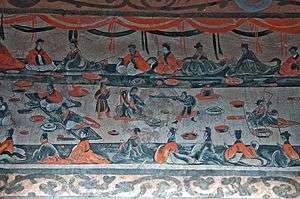
Trade with the Roman Empire, confirmed by the Roman craze for silk, started in the 1st century BC. Although the Romans knew of wild silk harvested on Cos (coa vestis), they did not at first make the connection with silk which was also produced in the Pamir Sarikol kingdom.[122] There were few direct trade contacts between Romans and Han Chinese, as the rivalling Parthians and Kushans were each protecting their lucrative role as trade intermediaries.[123][124]
During the 1st century BC silk was still a rare commodity in the Roman world, yet by the 1st century AD this exorbitant trade item became much more widely available.[125] In his Natural History (77–79 AD), Pliny the Elder provided a lament about the financial drain of coin from the Roman economy in order to purchase this expensive luxury item (citing the rough annual figure of 100 million sesterces):[125]
... we have come now to see ... journeys made to Seres [China] to obtain cloth, the abysses of the Red Sea explored for pearls, and the depths of the earth scoured for emeralds ... at the lowest computation, India and Seres and the [Arabian] Peninsula together drain our empire of one hundred million sesterces every year. That is the price that our luxuries and our womankind cost us.[125]
In 14 AD the Senate issued, in vain, an edict prohibiting the wearing of silk by men, yet it continued to flow into the Roman world unabated.[125] In addition to economic concerns that the importation of silk caused a huge outflow of wealth, silk clothes were also considered to be decadent and immoral:
I can see clothes of silk, if materials that do not hide the body, nor even one's decency, can be called clothes ... Wretched flocks of maids labour so that the adulteress may be visible through her thin dress, so that her husband has no more acquaintance than any outsider or foreigner with his wife's body.
Despite the claims by Pliny the Elder about the trade imbalance and much of Rome's coinage used to purchase silk, Warwick Ball asserts that the spice trade and purchase of other commodities was of much greater consequence for the Roman economy.[127] Trade items such as spice and silk had to be paid for with Roman gold coinage, since Roman products like glass were valued as exotic items yet glass was also produced locally, even in China.[121][125] In fact, locally produced Chinese glasswares date back to the Western Han era (202 BC – 9 AD).[128] In dealing with foreign states such as the Parthian Empire, the Han Chinese were perhaps more concerned with diplomatically outmaneuvering their chief enemies, the nomadic Xiongnu, than with establishing trade, since mercantile pursuits and the merchant class were frowned upon by the gentry who dominated the Han government.[129]
Roman and Byzantine currency discovered in China

Background

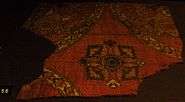
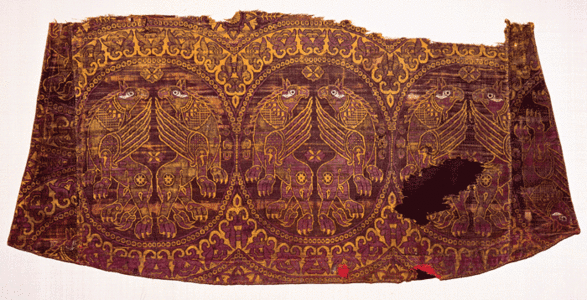
Shortly after the smuggling of silkworm eggs into the Byzantine Empire from China by Nestorian Christian monks, the 6th-century AD Byzantine historian Menander Protector writes of how the Sogdians attempted to establish a direct trade of Chinese silk with the Byzantine Empire. After forming an alliance with the Sasanian Persian ruler Khosrow I to defeat the Hephthalite Empire, Istämi, the Göktürk ruler of the Turkic Khaganate, was approached by Sogdian merchants requesting permission to seek an audience with the Sasanian king of kings for the privilege of traveling through Persian territories in order to trade with the Byzantines.[130] Istämi refused the first request, but when he sanctioned the second one and had the Sogdian embassy sent to the Sasanian king, the latter had the members of the embassy poisoned to death.[130] Maniakh, a Sogdian diplomat, convinced Istämi to send an embassy directly to Byzantium's capital Constantinople, which arrived in 568 AD and offered not only silk as a gift to Byzantine ruler Justin II, but also proposed an alliance against Sasanian Persia. Justin II agreed and sent an embassy under Zemarchus to the Turkic Khaganate, ensuring the direct silk trade desired by the Sogdians.[130][131][132]
Archaeological finds
It appears, however, that direct trade with the Sogdians remained limited in light of the small amount of Roman and Byzantine coins found in Central Asian and Chinese archaeological sites belonging to this era. This was despite the fact that ancient Romans imported Han Chinese silk,[133] while the Han-dynasty Chinese imported Roman glasswares as discovered in their tombs.[134] Valerie Hansen wrote as late as 2012 that no Roman coins from the Roman Republic (507–27 BC) or the Principate (27 BC – 284 AD) era of the Roman Empire have been found in China.[135] Yet Warwick Ball (2016) highlights a recent discovery at Xi'an, China (the site of the Han capital Chang'an) where a hoard of sixteen Roman coins from the reigns of Tiberius (14–37 AD) to Aurelian (270–275 AD) have been discovered.[127] The Roman coins found at Óc Eo, Vietnam, near Chinese-controlled Jiaozhou, date to the mid-2nd-century AD.[13][118] A coin of Maximian (r. 286–305 AD) was also discovered in Tonkin.[120] Roman coins of the 3rd and 4th centuries have also been discovered in Japan, yet they were unearthed from Katsuren Castle (in Uruma, Okinawa), which was built from the 12th to 15th centuries AD.[136]
The earliest gold solidus coins from the Eastern Roman Empire found in China date to the reign of Byzantine emperor Theodosius II (r. 408–450 AD) and altogether only forty-eight of them have been found (compared to thirteen-hundred silver coins) in Xinjiang and the rest of China.[135] The use of silver coins in Turfan persisted long after the Tang campaign against Karakhoja and Chinese conquest of 640 AD, with a gradual adoption of Chinese bronze coinage over the course of the 7th century AD.[135] Hansen maintains that these Eastern Roman coins were almost always found with Sasanian Persian silver coins and Eastern Roman gold coins were used more as ceremonial objects like talismans, confirming the pre-eminent importance of Greater Iran in Chinese Silk Road commerce of Central Asia compared to Eastern Rome.[137] Walter Scheidel remarks that the Chinese viewed Byzantine coins as pieces of exotic jewelry, preferring to use bronze coinage in the Tang and Song dynasties, as well as paper money during the Song and Ming periods, even while silver bullion was bountiful.[138] Ball contends that the scarcity of Roman and Byzantine coins in China, as opposed to the greater amounts found in India, confirms the idea that most Chinese silk purchased by the Romans was done so from maritime India, largely bypassing the overland Silk Road trade through Iran.[127] Chinese coins from the Sui and Tang dynasties (6th–10th centuries AD) have been discovered in India, yet significantly larger amounts are dated to the Song period (11th–13th centuries AD), particularly in territories of the coeval Chola dynasty.[139]
Even with the Byzantine production of silk starting in the 6th century AD, Chinese varieties were still considered of better quality, a fact that is perhaps underscored by the discovery of a Byzantine solidus minted during the reign of Justin II found in a Sui-dynasty tomb of Shanxi province in 1953, among other Byzantine coins found at various sites.[27] Chinese histories offer descriptions of Roman and Byzantine coins. The Weilüe, Book of Later Han, Book of Jin, as well as the later Wenxian Tongkao noted how ten ancient Roman silver coins were worth one Roman gold coin.[9][37][59][140] With fluctuations, the Roman golden aureus was worth about twenty-five silver denarii.[141] During the later Byzantine Empire, twelve silver miliaresion was equal to one gold nomisma.[142] The History of Song notes how the Byzantines made coins of either silver or gold, without holes in the middle yet with an inscription of the king's name.[9] It also asserted that the Byzantines forbade the production of counterfeit coins.[9]
Hypothetical military contact

The historian Homer H. Dubs speculated in 1941 that Roman prisoners of war who were transferred to the Parthian eastern border might have later clashed with Han troops there.[143]
After losing at the battle of Carrhae in 54 BC, an estimated 10,000 Roman prisoners were displaced by the Parthians to Margiana to man the frontier. Some time later the nomadic Xiongnu chief Zhizhi established a state further east in the Talas valley, near modern-day Taraz. Taking up these two strands, Dubs points to a Chinese account by Ban Gu of about "a hundred men" under the command of Zhizhi who fought in a so-called "fish-scale formation" to defend Zhizhi's wooden-palisade fortress against Han forces, in the Battle of Zhizhi in 36 BC. He claimed that this might have been the Roman testudo formation and that these men, who were captured by the Chinese, founded the village of Liqian (Li-chien, possibly from "legio") in Yongchang County.[144][145]
However, Dubs' synthesis of Roman and Chinese sources has never found acceptance among historians, on the grounds that it is highly speculative and reaches too many conclusions without sufficient hard evidence.[146] While DNA testing in 2005 confirmed the "Caucasian origin" of a few inhabitants of modern Liqian, this could be explained by transethnic marriages with Indo-European peoples known to have lived in Gansu in ancient times,[147][148][149] such as the Yuezhi and Wusun. A much more comprehensive DNA analysis of more than two hundred male residents of the village in 2007 showed a close genetic relation to the Han Chinese populace and a great deviation from the Western Eurasian gene pool.[150] The researchers conclude that the people of Liqian are probably of Han Chinese origin.[150] Moreover, the area lacks clear archaeological evidence of a Roman presence.[147][148][149]
Analysis of skeletons from Roman London
Recent analysis of archeological finds from Southwark in London, the site of the ancient Roman city Londinium in Roman Britain, suggest that two or possibly three skeletons from a sample of twenty-two skeletons dating to the 2nd through 4th centuries are of Asian ancestry, and are possibly of Chinese descent. The scientific method used to make this assertion is based on forensics and the analysis of skeletal facial features. The discovery has been presented by Dr Rebecca Redfern, curator of human osteology at the Museum of London.[151][152] However, no DNA analysis has yet been done, the skull and tooth samples available offer only fragmentary pieces of evidence, and the samples that were used were compared with the morphology of modern populations, not ancient ones.[153]
See also
- Indo-Roman relations
- Europeans in Medieval China, primarily in the 13th and 14th centuries, arriving again in the 16th century
- Marco Polo, 13th-century Venetian merchant and explorer in China
- The Malay Chronicles: Bloodlines and Dragon Blade, movies based on Sino-Roman relations
- Sihai Huayi Zongtu, 16th-century Chinese map of the Ming dynasty showing the western realm of Daqin
- Zhang Qian, Western-Han Chinese diplomat and explorer of Central Asia during the 2nd century BC
Footnotes
- ↑ Hill (2009), p. 5.
- ↑ Pulleyblank (1999), p. 77f.
- 1 2 3 4 Hill (2009), p. 27.
- 1 2 3 Pulleyblank (1999), p. 78
- 1 2 Yule (1915), pp 53–54.
- 1 2 Thorley (1971), pp 71–80.
- ↑ Schoff (1915), p. 237
- 1 2 Pulleyblank (1999), p. 71
- 1 2 3 4 5 6 7 8 9 10 11 12 13 14 15 16 17 18 19 20 21 22 23 24 25 26 27 28 29 30 31 32 33 34 35 36 Friedrich Hirth (2000) [1885]. Jerome S. Arkenberg, ed. "East Asian History Sourcebook: Chinese Accounts of Rome, Byzantium and the Middle East, c. 91 B.C.E. – 1643 C.E.". Fordham.edu. Fordham University. Retrieved 10 September 2016.
- 1 2 Wilkinson (2000), p. 730, footnote #14.
- 1 2 3 4 Ostrovsky (2007), p. 44.
- ↑ Yule (1915), pp 1–2, 11.
- 1 2 3 4 5 6 7 8 Young (2001), p. 29.
- ↑ Raoul McLaughlin (2010), pp 58–59.
- ↑ Suárez, Thomas (1999). Early Mapping of Southeast Asia. Singapore: Periplus Editions. ISBN 962-593-470-7, p. 92.
- 1 2 Parker (2008), p. 118.
- ↑ Schoff (2004) [1912], Introdution section. Retrieved 19 September 2016.
- 1 2 3 4 Schoff (2004) [1912], paragraph #64. Retrieved 19 September 2016.
- 1 2 Yule (1915), footnote #2 on p. 43.
- 1 2 3 Mawer (2013), p. 38.
- 1 2 3 McLaughlin (2014), p. 205.
- 1 2 Suárez (1999), p. 90.
- ↑ Yule (1915), p. 25.
- 1 2 Yule (1915), p. 28.
- ↑ Lieu (2009), p. 227.
- 1 2 3 Luttwak (2009), p. 168.
- 1 2 Luttwak (2009), pp. 168–169.
- ↑ Yule (1915), pp 29–31; footnote #3 on p. 31.
- 1 2 Yule (1915), p. 30; footnote #2 on p. 30.
- ↑ Yule (1915), p 29; footnote #4 on p. 29.
- ↑ Haw (2006), pp 170–171.
- ↑ Wittfogel & Feng (1946), p. 2.
- ↑ Yule (1915), p. 1.
- ↑ For the assertion that the first Chinese mention of Daqin belongs to the Book of Later Han, see: Wilkinson (2000), p. 730.
- ↑ Yule (1915), p. 41; footnote #4.
- ↑ Fan, Ye (September 2003). Hill, John E., ed. "The Western Regions according to the Hou Hanshu: The Xiyu juan, "Chapter on the Western Regions", from Hou Hanshu 88, Second Edition (Extensively revised with additional notes and appendices): Section 11 – The Kingdom of Da Qin 大秦 (the Roman Empire)". Depts.washington.edu. Translated by John E. Hill. Retrieved 26 September 2016.
- 1 2 3 4 5 6 7 8 9 Yu, Huan (September 2004). John E. Hill, ed. "The Peoples of the West from the Weilue 魏略 by Yu Huan 魚豢: A Third Century Chinese Account Composed between 239 and 265, Quoted in zhuan 30 of the Sanguozhi, Published in 429 CE". Depts.washington.edu. Translated by John E. Hill. Retrieved 17 September 2016.
- ↑ Needham, Joseph (1971). Science and Civilization in China: Volume 4, Physics and Physical Technology, Part 3: Civil Engineering and Nautics. Cambridge: Cambridge University Press; rpr. Taipei: Caves Books, Ltd, 1986, p. 662.
- 1 2 Yu, Huan (September 2004). John E. Hill, ed. "The Peoples of the West from the Weilue 魏略 by Yu Huan 魚豢: A Third Century Chinese Account Composed between 239 and 265, Quoted in zhuan 30 of the Sanguozhi, Published in 429 CE: Section 11 – Da Qin (Roman territory/Rome)". Depts.washington.edu. Translated by John E. Hill. Retrieved 17 September 2016.
- ↑ Hirth (2000) [1885], "From the Wei-lio (written before 429 C.E.), for 220-264 C.E.," (using Wade-Giles) identified these dependent vassal states as Alexandria-Euphrates or Charax Spasinu ("Ala-san"), Nikephorium ("Lu-fen"), Palmyra ("Ch'ieh-lan"), Damascus ("Hsien-tu"), Emesa ("Si-fu"), and Hira ("Ho-lat"). Going south of Palmyra and Emesa led one to the "Stony Land," which Hirth identified as Arabia Petraea, due to the text speaking how it bordered a sea (i.e. the Red Sea) where one could extract corals and real pearls. The text also explained the positions of border territories that were controlled by Parthia, such as Seleucia ("Si-lo").
Hill (September 2004), "Section 14 – Roman Dependencies," identified the dependent vassal states as Azania (Chinese: 澤散; pinyin: Zesan; Wade–Giles: Tse-san), Al Wajh (Chinese: 驢分; pinyin: Lüfen; Wade–Giles: Lü-fen), Wadi Sirhan (Chinese: 且蘭; pinyin: Qielan; Wade–Giles: Ch’ieh-lan), Leukos Limên, ancient site controlling the entrance to the Gulf of Aqaba near modern Aynūnah (Chinese: 賢督; pinyin: Xiandu; Wade–Giles: Hsien-tu), Petra (Chinese: 汜復; pinyin: Sifu; Wade–Giles: Szu-fu), al-Karak (Chinese: 于羅; pinyin: Yuluo; Wade–Giles: Yü-lo), and Sura (Chinese: 斯羅; pinyin: Siluo; Wade–Giles: Szu-lo). - ↑ Yule (1915), pp 46–48.
- ↑ Ball (2016), pp 152–153; see also endnote #114.
- ↑ Yule (1915), pp 48–49; for a brief summary of Edward Gibbon's account, see also footnote #1 on p. 49.
- ↑ Christopoulos (August 2012), pp 15–16.
- ↑ BBC News (12 October 2016). "BBC Western contact with China began long before Marco Polo, experts say." Bbc.co.uk. Accessed 12 October 2016.
- ↑ Stephanie Montgomery and Marcus Cammack (12 October 2016). "The Mausoleum of China’s First Emperor Partners with the BBC and National Geographic Channel to Reveal Groundbreaking Evidence That China Was in Contact with the West During the Reign of the First Emperor." Business Wire, businesswire.com. Accessed 12 October 2016.
- ↑ Sun (July 2009), p. 7.
- ↑ Yule (1915), p. 18; footnote#
- 1 2 Yule (1915), p. 18; for a discussion of Tiaozhi (条支) and even its etymology possibly stemming from the Tajiks and Iranian peoples under ancient Chinese rule, see footnote #2 on p. 42.
- ↑ Tremblay (2007), p. 77.
- ↑ Crespigny (2007), p 590.
- ↑ Yule (1915), p. 40.
- ↑ Crespigny (2007), pp 590–591.
- 1 2 Crespigny (2007), pp 239–240.
- ↑ Hill (2009), pp. 5, 481–483.
- 1 2 Fan, Ye (September 2003). Hill, John E., ed. "The Western Regions according to the Hou Hanshu: The Xiyu juan, "Chapter on the Western Regions", from Hou Hanshu 88, Second Edition (Extensively revised with additional notes and appendices)". Depts.washington.edu. Translated by John E. Hill. Retrieved 26 September 2016.
- 1 2 Hill (2009), pp. 23, 25.
- ↑ Hill (2009), p. xx.
- 1 2 Yule (1915), pp 43–44.
- ↑ Kumar (2005), pp 61–62.
- ↑ Hill (2009), p. 25.
- ↑ Hill, John E. (2012) Through the Jade Gate: China to Rome 2nd edition, p. 55. In press.
- ↑ His "Macedonian" origin betokens no more than his cultural affinity, and the name Maës is Semitic in origin (Cary 1956:130).
- ↑ The mainstream opinion, noted by Cary 1956:130 note 7, based on the date of Marinus, established by his use of many Trajanic foundation names but none identifiable with Hadrian.
- ↑ This is Cary's dating.
- ↑ Centuries later Tashkurgan ("Stone Tower") was the capital of the Pamir kingdom of Sarikol.
- ↑ Hill (2009), pp. xiii, 396,
- ↑ Stein (1907), pp. 44–45.
- ↑ Stein (1933), pp. 47, 292–295.
- 1 2 Ban Gu (班固), Houhanshu (後漢書) (Later Han dynasty annals), chap. 86, "Traditions of the Southern Savages; The South-Western Tribes" (Nanman, Xinanyi zhuan 南蠻西南夷列傳). Liezhuan 76. (Beijing: Zhonghua Shuju 中華書局, 1962–1999), p. 1926. "永初元年," 徼外僬僥種夷陸類等三千餘口舉種内附,献象牙、水牛、封牛。 永寧元年,撣國王雍由調复遣使者詣闕朝賀,献樂及幻人,能變化吐火,自支解,易牛馬頭。又善跳丸, 數乃至千。自言我海西人。海西即大秦也,撣國西南通大秦。明年元會,安帝作變於庭,封雍由調爲漢大 都尉,赐印綬、金銀、彩繒各有差也."
A translation of this passage into English, in addition to an explanation of how Greek athletic performers figured prominently in the neighboring Parthian and Kushan Empires of Asia, is offered by Christopoulos (August 2012), pp 40–41:
"The first year of Yongning (120 AD), the southwestern barbarian king of the kingdom of Chan (Burma), Yongyou, proposed illusionists (jugglers) who could metamorphose themselves and spit out fire; they could dismember themselves and change an ox head into a horse head. They were very skilful in acrobatics and they could do a thousand other things. They said that they were from the "west of the seas" (Haixi–Egypt). The west of the seas is the Daqin (Rome). The Daqin is situated to the south-west of the Chan country. During the following year, Andi organized festivities in his country residence and the acrobats were transferred to the Han capital where they gave a performance to the court, and created a great sensation. They received the honours of the Emperor, with gold and silver, and every one of them received a different gift." - ↑ McLaughlin (2014), pp 204–205.
- ↑ Yule (1915), pp 52–53.
- ↑ Christopoulos (August 2012), pp 40–41.
- ↑ Franz Cumont (1933), The Excavations of Dura-Europos: Preliminary Reports of the Seventh and Eighth Seasons of Work, Crai, New Haven, pp. 264–68.
- ↑ Christopoulos (August 2012), p. 41.
- 1 2 McLaughlin (2010), p. 58.
- 1 2 3 4 5 6 Ball (2016), p. 152.
- 1 2 de Crespigny (2007), p. 600.
- ↑ Yü (1986), pp 460–461.
- ↑ Hill (2009), p. 27 and nn. 12.18 and 12.20.
- ↑ Bang (2009), p. 120.
- ↑ de Crespigny. (2007), pp. 597–600.
- ↑ Yule (1915), pp 51–52.
- ↑ Yule (1915), p. 52.
- ↑ Hirth (1885), pp. 47–48.
- 1 2 Yule (1915), p. 53; please see footnotes #4–5.
- ↑ Yule (1915), pp 54–55.
- ↑ Schafer (1985), pp 10, 25–26.
- ↑ Yule (1915), pp 55–56.
- ↑ Sezgin (1996), p. 25.
- ↑ Bauman (2005), p. 23.
- ↑ Yule (1915), pp 56–57.
- 1 2 Bretschneider (1888), p. 144.
- ↑ Luttwak (2009), p. 169.
- ↑ An, (2002), pp 79, 82–83.
- ↑ Spielvogel (2011), p. 183.
- ↑ Jacobi (1999), pp 525–542.
- ↑ Reinert (2002), pp 257–261.
- ↑ Grant (2005), 99.
- ↑ Hirth (1885), p. 66.
- ↑ Luttwak (2009), p. 170.
- ↑ For information on Matteo Ricci and reestablishment of Western contact with China by the Portuguese Empire during the Age of Discovery, see: Fontana (2011), pp 18–35, 116–118.
- ↑ McLaughlin (2010), p. 25.
- ↑ McLaughlin (2010), pp 34–57.
- ↑ de Crespigny. (2007), pp 514, 600.
- ↑ McLaughlin (2010), p. 58–60.
- ↑ An (2002), p. 82.
- ↑ An (2002), p. 83.
- ↑ An (2002), pp 83–84.
- ↑ Hee Soo Lee (7 June 2014). "1,500 Years of Contact between Korea and the Middle East." Middle East Institute, mei.edu. Accessed 27 September 2016.
- ↑ The Huffington Post (27 June 2012). "Japanese Tomb Found To House Rare Artifacts From Roman Empire." Huffingtonpost.com. Accessed 26 September 2016.
- ↑ Hill (2009), Appendix B – Sea Silk, pp. 466–476.
- ↑ Harper (2002), pp 99–100, 106–107.
- 1 2 Osborne (2006), pp 24–25.
- ↑ Hill (2009), p. 291.
- ↑ Ferdinand von Richthofen, China, Berlin, 1877, Vol.I, pp. 504–510; cited in Richard Hennig,Terrae incognitae : eine Zusammenstellung und kritische Bewertung der wichtigsten vorcolumbischen Entdeckungsreisen an Hand der daruber vorliegenden Originalberichte, Band I, Altertum bis Ptolemäus, Leiden, Brill, 1944, pp.387, 410–411; cited in Zürcher (2002), pp. 30–31.
- ↑ For a small summary of scholarly debate about the possible locations of Cattigara by the end of the 20th century, with proposals ranging from Guangzhou, Hanoi, and the Mekong River Delta of the Kingdom of Funan, see: Suárez (1999), p. 92.
- 1 2 3 4 O'Reilly (2007), p. 97.
- ↑ Young (2001), pp 29–30
- 1 2 Ball (2016), p. 153.
- 1 2 Ball (2016), pp 153–154.
- ↑ Schoff (1915), p. 229
- ↑ Thorley (1979), pp. 181–190 (187f.)
- ↑ Thorley (1971), pp. 71–80 (76)
- 1 2 3 4 5 Whitfield (1999), p. 21.
- ↑ Seneca (1974), p. 375.
- 1 2 3 Ball (2016), p. 154.
- ↑ An (2002), pp 82–83.
- ↑ Ball (2016), p. 155.
- 1 2 3 Howard (2012), p. 133.
- ↑ Liu (2001), p. 168.
- ↑ Dresden (1981), p. 9.
- ↑ Brosius (2006), pp. 122–123.
- ↑ An (2002), pp. 79–94.
- 1 2 3 Hansen (2012), p. 97.
- ↑ The Japan Times (26 September 2016). "Ancient Roman coins unearthed from castle ruins in Okinawa." Japantimes.co.jp. Accessed 26 September 2016.
- ↑ Hansen (2012), pp. 97–98.
- ↑ Scheidel (2009), p. 186.
- ↑ Bagchi (2011), pp. 137–144.
- ↑ Scheidel (2009), footnote #239 on p. 186.
- ↑ John Pike. (last modified 11-07-2011). "Roman Money." Globalsecurity.org. Accessed 14 September 2016.
- ↑ Yule (1915), footnote #1 on p. 44.
- ↑ Dubs (1941), pp. 322–330
- ↑ Hoh, Erling (May–June 1999). "Romans in China?". Archaeology.org. Archaeological Institute of America. Retrieved 10 September 2016.
- ↑ China Daily (24 August 2005). "Romans in China stir up controversy". News.xinhuanet.com. Retrieved 10 September 2016.
- ↑ Ethan Gruber (2007). The Origins of Roman Li-chien. Academia.edu, pp. 18–21.
- 1 2 China Daily: Hunt for Roman Legion Reaches China, 20 November 2010, retrieved 4 June 2012
- 1 2 The Daily Telegraph: Chinese Villagers 'Descended from Roman Soldiers', 23 November 2010, retrieved 4 June 2012
- 1 2 Mail Online: DNA Tests Show Chinese Villagers with Green Eyes Could Be Descendants of Lost Roman Legion, 29 November 2010, retrieved 4 June 2012
- 1 2 R. Zhou et al.: Testing the Hypothesis of an Ancient Roman Soldier Origin of the Liqian People in Northwest China: a Y-Chromosome Perspective, in: Journal of Human Genetics, Vol. 52, No. 7 (2007), pp. 584–91
- ↑ BBC (23 September 2016). "Skeleton find could rewrite Roman history." Bbc.co.uk. Accessed 24 September 2016.
- ↑ Rebecca C. Redfern et. al. "Going south of the river: A multidisciplinary analysis of ancestry, mobility and diet in a population from Roman Southwark, London." Journal of Archaeological Science, Volume 74, October 2016, pp 11–22. Accessed 24 September 2016.
- ↑ Kristina Killgrove. (23 September 2016). "Chinese Skeletons In Roman Britain? Not So Fast." Forbes.com. Accessed 25 September 2016.
References
- An, Jiayao. (2002). "When Glass Was Treasured in China," in Annette L. Juliano and Judith A. Lerner (eds), Silk Road Studies VII: Nomads, Traders, and Holy Men Along China's Silk Road, 79–94. Turnhout: Brepols Publishers. ISBN 2-503-52178-9.
- Bagchi, Prabodh Chandra (2011). Bangwei Wang and Tansen Sen (eds), India and China: Interactions Through Buddhism and Diplomacy: a Collection of Essays by Professor Prabodh Chandra Bagchi. London, New York, Delhi: Anthem Press. ISBN 93-80601-17-4.
- Ball, Warwick (2016). Rome in the East: Transformation of an Empire, 2nd edition. London & New York: Routledge, ISBN 978-0-415-72078-6.
- Bang, Peter F. (2009). "Commanding and Consuming the World: Empire, Tribute, and Trade in Roman and Chinese History," in Walter Scheidel (ed), Rome and China: Comparative Perspectives on Ancient World Empires, 100–120. Oxford & New York: Oxford University Press. ISBN 978-0-19-975835-7.
- Bauman, Richard A. (2005). Crime and Punishment in Ancient Rome. London & New York: Routledge, reprint of 1996 edition. ISBN 0-203-42858-7.
- Bretschneider, Emil (1888). Medieval Researches from Eastern Asiatic Sources: Fragments Towards the Knowledge of the Geography and History of Central and Western Asia from the 13th to the 17th Century, Vol. 1. Abingdon: Routledge, reprinted 2000.
- Christopoulos, Lucas (August 2012). "Hellenes and Romans in Ancient China (240 BC – 1398 AD)," in Victor H. Mair (ed), Sino-Platonic Papers, No. 230. Chinese Academy of Social Sciences, University of Pennsylvania Department of East Asian Languages and Civilizations. ISSN 2157-9687.
- Brosius, Maria (2006). The Persians: An Introduction. London & New York: Routledge. ISBN 0-415-32089-5.
- de Crespigny, Rafe (2007). A Biographical Dictionary of Later Han to the Three Kingdoms (23–220 AD). Leiden: Koninklijke Brill. ISBN 978-90-04-15605-0.
- Cumont, Franz (1933). The Excavations of Dura-Europos: Preliminary Reports of the Seventh and Eighth Seasons of Work. New Haven: Crai.
- Dresden, Mark J. (1981). "Introductory Note," in Guitty Azarpay (ed.), Sogdian Painting: the Pictorial Epic in Oriental Art. Berkeley, Los Angeles, London: University of California Press. ISBN 0-520-03765-0.
- Dubs, Homer H. "An Ancient Military Contact between Romans and Chinese," in The American Journal of Philology, Vol. 62, No. 3 (1941), pp. 322–330.
- Fan, Ye (September 2003). Hill, John E., ed. "The Western Regions according to the Hou Hanshu: The Xiyu juan, "Chapter on the Western Regions", from Hou Hanshu 88, Second Edition (Extensively revised with additional notes and appendices)". Depts.washington.edu. Translated by John E. Hill. Retrieved 26 September 2016.
- Fontana, Michela (2011). Matteo Ricci: a Jesuit in the Ming Court. Lanham: Rowman & Littlefield Publishers. ISBN 978-1-4422-0586-4.
- Grant, R.G. (2005). Battle: A Visual Journey Through 5,000 Years of Combat. DK Pub. ISBN 978-0-7566-1360-0.
- Hansen, Valerie (2012). The Silk Road: A New History. Oxford: Oxford University Press. ISBN 978-0-19-993921-3.
- Harper, P.O. (2002). "Iranian Luxury Vessels in China From the Late First Millennium B.C.E. to the Second Half of the First Millennium C.E.," in Annette L. Juliano and Judith A. Lerner (eds), Silk Road Studies VII: Nomads, Traders, and Holy Men Along China's Silk Road, 95–113. Turnhout: Brepols Publishers. ISBN 2-503-52178-9.
- Haw, Stephen G. (2006). Marco Polo's China: a Venetian in the Realm of Kublai Khan. London & New York: Routledge, ISBN 0-415-34850-1.
- Hill, John E. (2009). Through the Jade Gate to Rome: A Study of the Silk Routes during the Later Han Dynasty, First to Second Centuries CE. BookSurge. ISBN 978-1-4392-2134-1.
- Hirth, Friedrich (2000) [1885]. Jerome S. Arkenberg, ed. "East Asian History Sourcebook: Chinese Accounts of Rome, Byzantium and the Middle East, c. 91 B.C.E. – 1643 C.E.". Fordham.edu. Fordham University. Retrieved 10 September 2016.
- Hirth, Friedrich (1885): China and the Roman Orient. 1875. Shanghai and Hong Kong. Unchanged reprint. Chicago, Ares Publishers, 1975.
- Hoh, Erling (May–June 1999). "Romans in China?". Archaeology.org. Archaeological Institute of America. Retrieved 10 September 2016.
- Howard, Michael C. (2012). Transnationalism in Ancient and Medieval Societies: the Role of Cross Border Trade and Travel. McFarland & Company.
- Jacobi, David (1999), "The Latin empire of Constantinople and the Frankish states in Greece", in David Abulafia (ed), The New Cambridge Medieval History, Volume V: c. 1198–c. 1300. Cambridge: Cambridge University Press, pp. 525–542. ISBN 0-521-36289-X.
- Kumar, Yukteshwar. (2005). A History of Sino-Indian Relations, 1st Century A.D. to 7th Century A.D.: Movement of Peoples and Ideas between India and China from Kasyapa Matanga to Yi Jing. New Delhi: APH Publishing. ISBN 81-7648-798-8.
- Lieu, Samuel N.C. (2009). "Epigraphica Nestoriana Serica" in Werner Sundermann, Almut Hintze, and Francois de Blois (eds), Exegisti monumenta Festschrift in Honour of Nicholas Sims-Williams, pp 227–246. Weisbaden: Harrassowitz Verlag. ISBN 978-3-447-05937-4.
- Liu, Xinru (2001). "The Silk Road: Overland Trade and Cultural Interactions in Eurasia", in Michael Adas (ed.), Agricultural and Pastoral Societies in Ancient and Classical History. Philadelphia: Temple University Press, American Historical Association.
- Luttwak, Edward N. (2009). The Grand Strategy of the Byzantine Empire. Cambridge and London: The Belknap Press of Harvard University Press. ISBN 978-0-674-03519-5.
- Mawer, Granville Allen (2013). "The Riddle of Cattigara" in Robert Nichols and Martin Woods (eds), Mapping Our World: Terra Incognita to Australia, 38–39, Canberra: National Library of Australia. ISBN 978-0-642-27809-8.
- McLaughlin, Raoul (2010). Rome and the Distant East: Trade Routes to the Ancient Lands of Arabia, India, and China. London & New York: Continuum, ISBN 978-1-84725-235-7.
- McLaughlin, Raoul (2014). The Roman Empire and the Indian Ocean: the Ancient World Economy and the Kingdoms of Africa, Arabia, and India. Barnsley: Pen & Sword Military. ISBN 978-1-78346-381-7.
- Needham, Joseph (1971). Science and Civilization in China: Volume 4, Physics and Physical Technology, Part 3: Civil Engineering and Nautics. Cambridge: Cambridge University Press; rpr. Taipei: Caves Books, Ltd, 1986.
- Olschki, Leonardo (1960). Marco Polo's Asia: An Introduction to His "Description of the World" Called "Il Milione." Berkley, Los Angeles, London: University of California Press and Cambridge University Press.
- O'Reilly, Dougald J.W. (2007). Early Civilizations of Southeast Asia. Lanham, New York, Toronto, Plymouth: AltaMira Press, Division of Rowman and Littlefield Publishers. ISBN 0-7591-0279-1.
- Osborne, Milton (2006). The Mekong: Turbulent Past, Uncertain Future. Crows Nest: Allen & Unwin, revised edition, first published in 2000. ISBN 1-74114-893-6
- Ostrovsky, Max (2007), Y = Arctg X: the Hyperbola of the World Order, Lanham, Boulder, New York, Toronto, Plymouth: University Press of America, ISBN 0-7618-3499-0.
- Parker, Grant (2008). The Making of Roman India. Cambridge and New York: Cambridge University Press. ISBN 978-0-521-85834-2.
- Pike, John. (last modified 11-07-2011). "Roman Money." Globalsecurity.org. Accessed 14 September 2016.
- Pulleyblank, Edwin G.: "The Roman Empire as Known to Han China", Journal of the American Oriental Society, Vol. 119, No. 1 (1999), pp. 71–79
- Redfern, Rebecca C. et al. "Going south of the river: A multidisciplinary analysis of ancestry, mobility and diet in a population from Roman Southwark, London." Journal of Archaeological Science, Volume 74, October 2016, pp 11–22. Accessed 24 September 2016.
- Reinert, Stephen W. (2002). "Fragmentation (1204–1453)," in Cyril Mango (ed), The Oxford History of Byzantium. Oxford: Oxford University Press, pp 248–283. ISBN 0-19-814098-3.
- von Richthofen, Ferdinand. (1877). China. Vol.I. Berlin; cited in Richard Hennig (1944), Terrae incognitae : eine Zusammenstellung und kritische Bewertung der wichtigsten vorcolumbischen Entdeckungsreisen an Hand der daruber vorliegenden Originalberichte, Band I, Altertum bis Ptolemäus. Leiden, Brill.
- Schafer, Edward H. (1985) [1963], The Golden Peaches of Samarkand: A study of T'ang Exotics (1st paperback ed.), Berkeley and Los Angeles: University of California Press, ISBN 0-520-05462-8.
- Scheidel, Walter (2009). "The Monetary Systems of the Han and Roman Empires," in Walter Scheidel (ed), Rome and China: Comparative Perspectives on Ancient World Empires, 137–208. Oxford & New York: Oxford University Press. ISBN 978-0-19-975835-7.
- Schoff, William H. (2004) [1912]. Lance Jenott, ed. ""The Periplus of the Erythraean Sea: Travel and Trade in the Indian Ocean by a Merchant of the First Century" in The Voyage around the Erythraean Sea". Depts.washington.edu. University of Washington. Retrieved 19 September 2016.
- Schoff, W. H. (1915). The Eastern Iron Trade of the Roman Empire. [New Haven].
- Seneca, Lucius Annaeus, (1974). Michael Winterbottom (trans), Declamations, Volume I: Controversiae, Books 1–6. Cambridge: Harvard University Press. ISBN 978-0-674-99511-6.
- Sezgin, Fuat; Carl Ehrig-Eggert; Amawi Mazen; E. Neubauer (1996). نصوص ودراسات من مصادر صينية حول البلدان الاسلامية. Frankfurt am Main: Institut für Geschichte der Arabisch-Islamischen Wissenschaften (Institute for the History of Arabic-Islamic Science at the Johann Wolfgang Goethe University).
- Spielvogel, Jackson J. (2011). Western Civilization: a Brief History. Boston: Wadsworth, Cencage Learning. ISBN 0-495-57147-4.
- Stein, Aurel M. (1907), Ancient Khotan: Detailed report of archaeological explorations in Chinese Turkestan. 2 vols. pp. 44–45. M. Aurel Stein. Oxford, Clarendon Press.
- Stein, Aurel M. (1932), On Ancient Central Asian Tracks: Brief Narrative of Three Expeditions in Innermost Asia and Northwestern China, pp. 47, 292–295. Reprinted with Introduction by Jeannette Mirsky. Book Faith India, Delhi. 1999.
- Suárez, Thomas (1999). Early Mapping of Southeast Asia. Singapore: Periplus Editions. ISBN 962-593-470-7.
- Sun, Zhixin Jason. "Life and Afterlife in Early Imperial China," in American Journal of Archaeology, Vol. 113, No. 3 (July 2009): 1-9. DOI: 10.3764/ajaonline1133.Sun.
- Thorley, John (1971), The Silk Trade between China and the Roman Empire at Its Height, 'Circa' A. D. 90–130, Greece & Rome, Vol. 18, No. 1 (1971), pp. 71–80.
- Thorley, John. "The Roman Empire and the Kushans," in Greece & Rome, Vol. 26, No. 2 (1979), pp. 181–190 (187f.).
- Tremblay, Xavier (2007). "The Spread of Buddhism in Serindia: Buddhism Among Iranians, Tocharians and Turks before the 13th Century," in Ann Heirman and Stephan Peter Bumbacker (eds), The Spread of Buddhism. Leiden & Boston: Koninklijke Brill. ISBN 978-90-04-15830-6.
- Whitfield, Susan (1999). Life Along the Silk Road. Berkeley & Los Angeles: University of California Press. ISBN 0-520-23214-3.
- Wilkinson, Endymion (2000). Chinese History: a Manual, Revised and Enlarged, Cambridge & London: Harvard University Press, ISBN 0-674-00247-4.
- Wittfogel, Karl A. and Feng Chia-Sheng. "History of Chinese Society: Liao (907–1125)," in Transactions of American Philosophical Society (vol. 36, Part 1, 1946).
- Young, Gary K. (2001). Rome's Eastern Trade: International Commerce and Imperial Policy, 31 BC – AD 305. London & New York: Routledge, ISBN 0-415-24219-3.
- Yu, Huan (September 2004). John E. Hill, ed. "The Peoples of the West from the Weilue 魏略 by Yu Huan 魚豢: A Third Century Chinese Account Composed between 239 and 265, Quoted in zhuan 30 of the Sanguozhi, Published in 429 CE". Depts.washington.edu. Translated by John E. Hill. Retrieved 17 September 2016.
- Yü, Ying-shih. (1986). "Han Foreign Relations," in Denis Twitchett and Michael Loewe (eds), The Cambridge History of China: Volume I: the Ch'in and Han Empires, 221 B.C. – A.D. 220, 377–462. Cambridge: Cambridge University Press. ISBN 978-0-521-24327-8.
- Yule, Henry (1915). Henri Cordier (ed.), Cathay and the Way Thither: Being a Collection of Medieval Notices of China, Vol I: Preliminary Essay on the Intercourse Between China and the Western Nations Previous to the Discovery of the Cape Route. London: Hakluyt Society. Accessed 21 September 2016.
- Zhou R., An L., Wang X., Shao W., Lin G., Yu W., Yi L., Xu S., Xu J., Xie X. "Testing the hypothesis of an ancient Roman soldier origin of the Liqian people in northwest China: a Y-chromosome perspective," in Journal of Human Genetics, Vol. 52, No. 7 (2007), pp. 584–91.
- Zürcher, Erik (2002): "Tidings from the South, Chinese Court Buddhism and Overseas Relations in the Fifth Century AD." Erik Zürcher in: A Life Journey to the East. Sinological Studies in Memory of Giuliano Bertuccioli (1923–2001). Edited by Antonio Forte and Federico Masini. Italian School of East Asian Studies. Kyoto. Essays: Volume 2, pp. 21–43.
Further reading
- Leslie, D. D., Gardiner, K. H. J.: "The Roman Empire in Chinese Sources", Studi Orientali, Vol. 15. Rome: Department of Oriental Studies, University of Rome, 1996.
- Schoff, Wilfred H.: "Navigation to the Far East under the Roman Empire", Journal of the American Oriental Society, Vol. 37 (1917), pp. 240–249
- André Bueno (May 2016). ""Roman Views of the Chinese in Antiquity" in SINO-PLATONIC PAPERS" (PDF). Sino-platonic.org. Retrieved 10 September 2016.
External links
- Accounts of "Daqin" (Roman Empire) in the Chinese history of the Later Han Dynasty
- Silk-road.com: The First Contact Between Rome and China
- Roman silver plate with figure of Dionysus, discovered at Beitan, Jingyuan, Gansu Province, China in 1988, Madison Digital Image Database, James Madison University
- Duncan B. Campbell: Romans in China?
